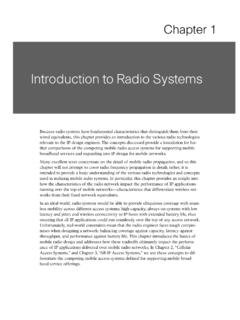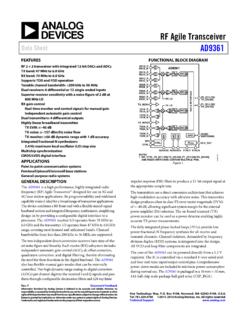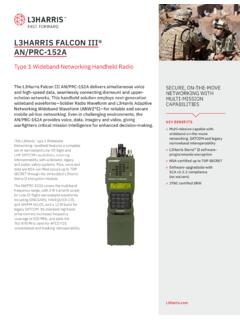Transcription of Tactical Single-Channel Radio Communications Techniques
1 FM 24-18 TABLE OF CONTENTSRDLH omepageDocumentInformationHEADQUARTERSDE PARTMENT OF THE ARMYWASHINGTON, 30 SEPTEMBER 1987FM 24-18 Tactical Single-Channel Radio Communications TECHNIQUESTABLE OF CONTENTS I. PREFACEII. CHAPTER 1 INTRODUCTION TO Single-Channel Radio COMMUNICATIONSIII. CHAPTER 2 Radio PRINCIPLESS ection I. Theory and PropagationSection II. Types of Modulation and Methods of Transmission IV. CHAPTER 3 (1 of 3) [1/11/2002 1:54:49 PM]FM 24-18 TABLE OF CONTENTSS ection I. Requirement and FunctionSection II. CharacteristicsSection III. Types of AntennasSection IV. Field Repair and Expedients V. CHAPTER 4 PRACTICAL CONSIDERATIONS IN OPERATING Single-Channel RADIOSS ection I. Siting ConsiderationsSection II. Transmitter Characteristics and Operator's SkillsSection III. Transmission PathsSection IV. receiver Characteristics and Operator's Skills VI. CHAPTER 5 Radio OPERATING TECHNIQUESS ection I.
2 General Operating Instructions and SOIS ection II. Radiotelegraph ProceduresSection III. Radiotelephone and Radio Teletypewriter Procedures VII. CHAPTER 6 ELECTRONIC WARFAREVIII. CHAPTER 7 Radio OPERATIONS UNDER UNUSUAL CONDITIONSS ection I. Operations in Arcticlike AreasSection II. Operations in Jungle AreasSection III. Operations in Desert AreasSection IV. Operations in Mountainous AreasSection V. Operations in Special Environments IX. CHAPTER 8 SPECIAL OPERATIONS AND INTEROPERABILITY TECHNIQUESS ection I. Retransmission and Remote Control OperationsSection II. Secure OperationsSection III. Equipment Compatibility and Netting Procedures X. APPENDIX A POWER (2 of 3) [1/11/2002 1:54:49 PM]FM 24-18 TABLE OF CONTENTSXI. APPENDIX B IONOSPHERIC SOUNDER AN/TRQ-35(V)XII. APPENDIX C EXTENDED FREQUENCY RANGE, MULTIMODE FIELD Radio SET AN/PRC-70 XIII. APPENDIX D TRANSCEIVER MULTIPLEXER(TD-1288( )/GRC AND TD-1289( )(V)/GRC)XIV.
3 APPENDIX E STEERABLE NULL PROCESSING GROUP OL-275( )/VRCXV. APPENDIX F NET Radio INTERFACES ection I. Purpose and ScopeSection II. Doctrine and DeploymentSection III. OperationSection IV. Radio Set Control C-6709/G XVI. APPENDIX G TIME ZONE CHART XVII. APPENDIX H TIME CONVERSION TABLE XVIII. APPENDIX I CIRCUIT LOG AND OPERATOR'S NUMBER SHEET XIX. APPENDIX J ELECTROMAGNETIC PULSE XX. APPENDIX K NBC PROTECTION XXI. APPENDIX L TACTIC Single-Channel Communications XXII. APPENDIX M NEAR-VERTICAL INCIDENCE SKY-WAVE PROPAGATION CONCEPT XXIII. GLOSSARY XXIV. REFERENCES XXV. AUTHORIZATION (3 of 3) [1/11/2002 1:54:49 PM]FM 24-18 PREFACE ( Tactical Single-Channel Radio Communications Techniques )RDLH omepageTable ofContentsDocumentInformationPREFACEP urpose and Scope This manual provides information and guidance to all personnel who are involved with and use Single-Channel Radio in Tactical situations.
4 To ensure your understanding of all the material presented, this manual includes a brief discussion of Radio fundamentals, antennas, and Radio -wave propagation. It also covers procedures and Techniques that have been used effectively during Tactical operations to include: site selection and reliability factors; operation in the several transmission modes and under unusual conditions; field expedients; electronic warfare Techniques and reporting; and other aspects of the practical applications of Single-Channel Radio . There are other items pertinent to Single-Channel Radio operations listed in the appendixes. User Information The proponent of this publication is HQ TRADOC. You are encouraged to submit comments and recommended changes to improve this manual. Submit you comments on DA Form 2028 (Recommended Changes to Publications and Blank Forms) and key them to the pages, paragraphs, and lines of text to which they apply.
5 If DA Form 2028 is not available, a letter is acceptable. Provide reasons for your comments to ensure complete understanding and proper evaluation. Forward your comments to the Commander, United States Army Signal Center and Fort Gordon, ATTN: ATZH-DTL, Fort Gordon, Georgia 30905-5070. The provisions of this publication are the subject of the following international agreement(s): STANAG 2019 (Military Symbols). DISTRIBUTION RESTRICTION: Distribution authorized to Government agencies and their contractors to prevent valuable technical or operational information from automatic dissemination under the International Exchange Program or by other means. This determination was made on 10 December 1986. Other requests for this document will be referred to Commander, Army Signal Center and Fort Gordon, ATTN: ATZH-DTL, Fort Gordon, GA 30905-5070. DESTRUCTION NOTICE: Destroy by any method that will prevent disclosure of contents or reconstruction of the document.
6 (1 of 2) [1/11/2002 1:54:54 PM]FM 24-18 PREFACE ( Tactical Single-Channel Radio Communications Techniques )*This manual supersedes FM 24-18, 13 December a word normally referring to a particular sex appears within this publication, it is intended to include both masculine and feminine genders. (2 of 2) [1/11/2002 1:54:54 PM]FM 24-18 CHPTR 1 INTRO TO Single-Channel Radio COMMRDLH omepageTable ofContentsDocumentInformationCHAPTER 1 INTRODUCTION TOSINGLE-CHANNEL RADIOCOMMUNICATIONS1-1. Employment of Radio Communications Mobility is one of the keys to success on the modern battlefield. All Communications must be geared to support a combat force that must repeatedly move to survive and fight the enemy. The Single-Channel Radio is the primary means of communication for command, fire control, exchange of information, administration, and liaison between and within units. The versatility of Radio Communications makes it readily adaptable to rapidly changing Tactical situations.
7 Radio is essential for Communications over large bodies of water, territory controlled by enemy forces, and terrain where the construction of wire lines is impossible or impractical. It is also required for air assault operations. 1-2. Capabilities and Limitations The capabilities of the Single-Channel Radio make it flexible, securable, mobile, and reliable. Radio Communications facilities usually can be installed more quickly than wire Communications . Thus, Radio can be used as a primary means of Communications during the initial stages of combat operations. Once installed in a vehicle, aircraft, or ship, the equipment is ready for use and does not require reinstallation. Wire Communications require reinstallation with each move. Radio equipment is designed to meet mobility requirements and is used by airmobile, amphibious, mechanized, and dismounted units. Radio lends itself to many modes of operation, such as radiotelephone, radiotelegraph, Radio teletypewriter (RATT), visual presentation, and data.
8 All of the modes of operation are securable when required equipment is available. (1 of 2) [1/11/2002 1:54:57 PM]FM 24-18 CHPTR 1 INTRO TO Single-Channel Radio COMMN atural obstacles, minefields, and terrain under enemy control or fire do not limit Radio to the same extent that they limit other means of Communications . By using special Techniques , Radio can interface with other Communications means (net Radio interface), be separated from the immediate vicinity of the user (remoting), and operate over extended distances (retransmission). The limitations of Single-Channel Radio must also be considered. Radio is the most detectable means of electronic Communications and is subject to intentional and unintentional electronic interference. Current Threat conditions require good electronic counter-countermeasures (ECCM) to include remoting Techniques . To be capable of operating together, radios must have common or at least some overlapping frequencies.
9 They must transmit and receive the same type signal and must be located within operating range of each other with a clear transmission path. Radio is the least secure means of Communications , and it must be assumed that interception occurs every time a transmitter is placed in operation. 1-3. Tactical Applications The extent to which Radio is used in combat operations depends on the requirements for secrecy and surprise balanced against the urgency of Communications . When surprise is important, Radio operation is limited initially to those units already in contact with the enemy. In some instances, to increase deception and surprise, the operation of dummy stations may be directed by higher commanders. When a unit is moving into an area just prior to attack, it may be directed to maintain listening silence until the attack is launched. When a unit is already occupying a sector from which it is to launch an attack, and its Radio stations are in operation, it may be directed to maintain normal Radio operations without substantial change in traffic load until the attack is launched.
10 If a unit is moved to another sector or is relieved by another unit, it may be required to provide dummy Radio stations to continue operations until the attack is fully underway. Once the attack is launched, special restrictions on Radio operations are generally removed. (2 of 2) [1/11/2002 1:54:57 PM]FM 24-18 CHPTR 2 Radio PRINCIPLESRDLH omepageTable ofContentsDocumentInformationCHAPTER 2 Radio PRINCIPLESS ection I. Theory and Propagation2-1. The Radio Set Basic Components. A Radio set (fig 2-1) consists basically of a transmitter and a receiver . Other items necessary for operation include a source of electrical power and an antenna for radiation and reception of Radio waves. The transmitter contains an oscillator which generates Radio frequency (RF) energy in the form of alternating current (AC). A transmission line or cable feeds the RF to the antenna. The antenna converts the AC into electromagnetic energy which is radiated into space.

















